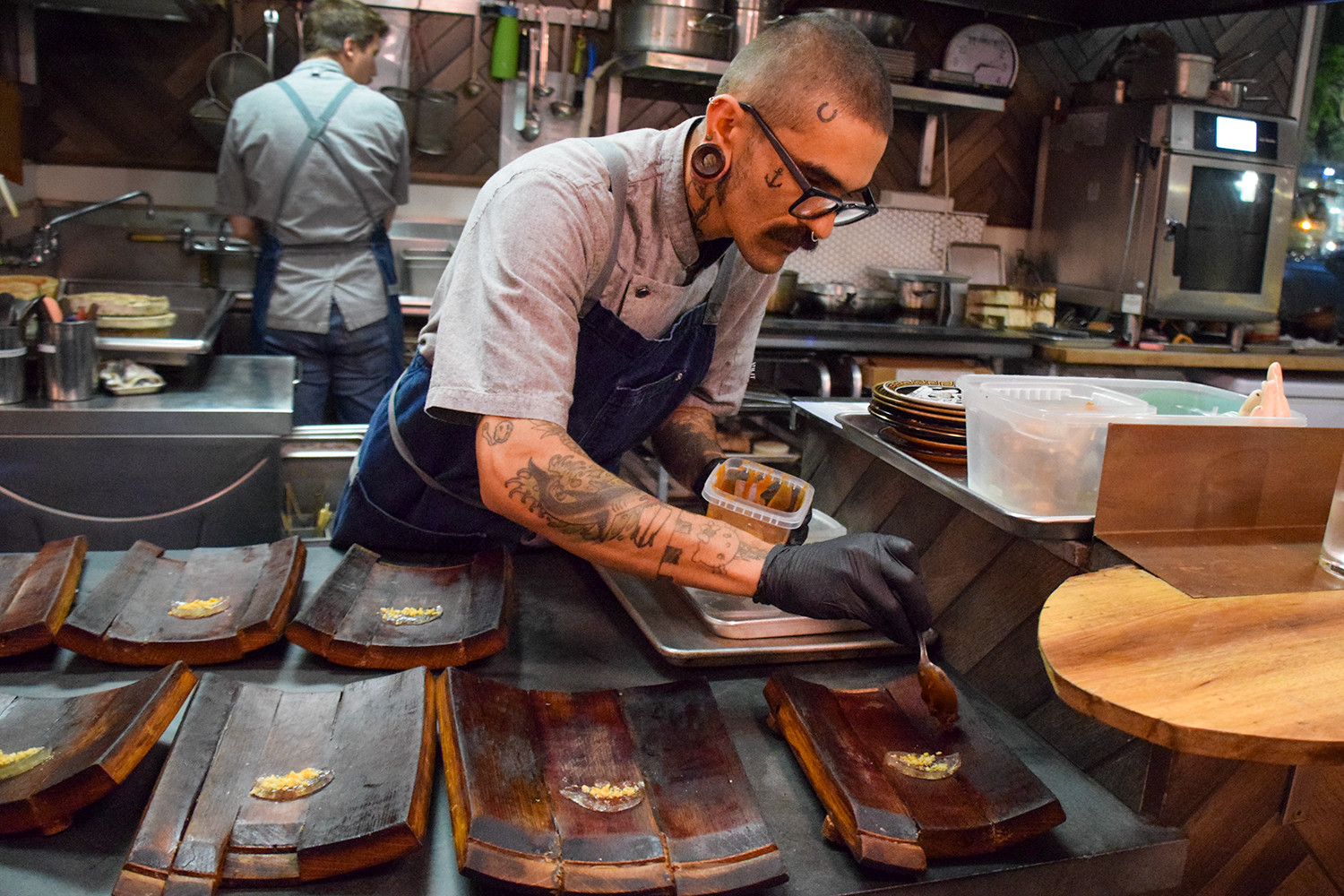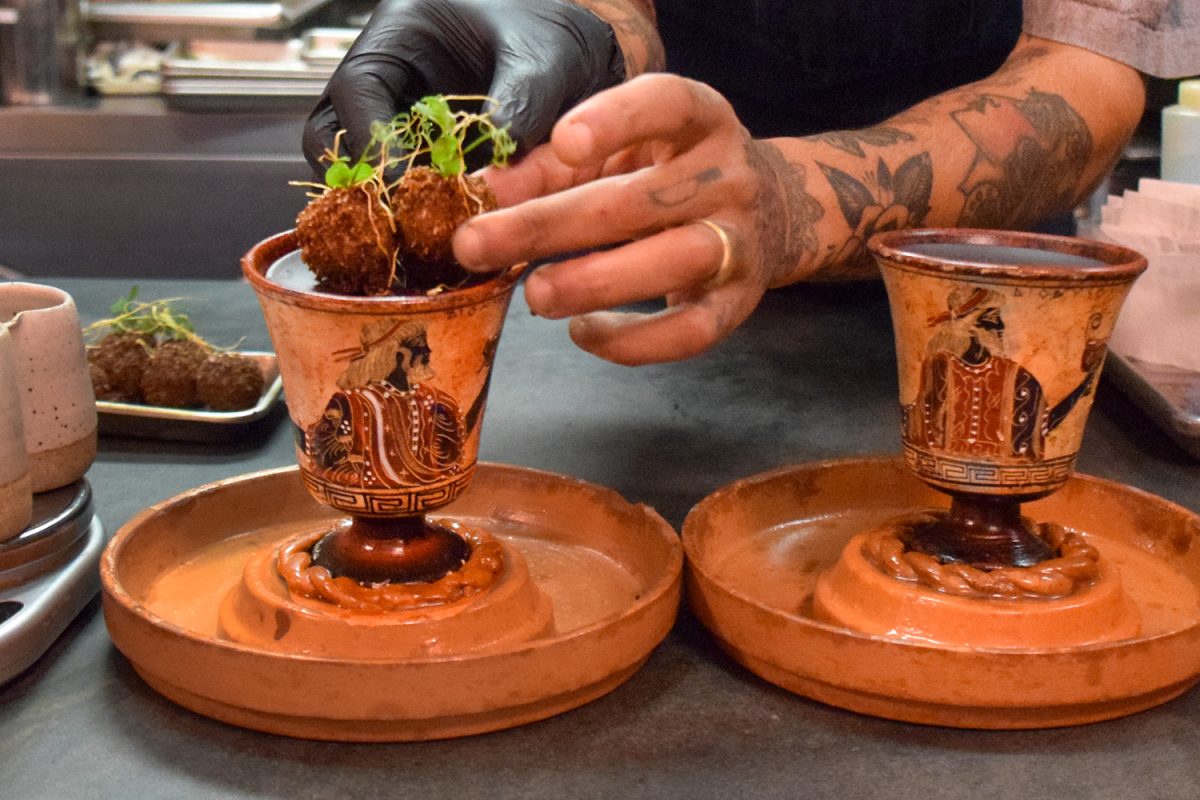In the culinary world, where flavor reigns supreme, there exists an often underestimated but equally important factor of the culinary experience. From Michelin-starred restaurants to cozy neighborhood cafes, food presentation can be the defining factor between a memorable or utterly forgettable dining experience.
“Food presentation in the culinary arts is more than just an aesthetic concern,” said Andrew Lindsay, a teacher at the Auguste Escoffier School of Culinary Arts. “Well-executed food presentation enhances visual appeal, stimulates the appetite, influences flavor perception, ensures balance, and adds to the cultural and artistic aspects of the meal.”
For many chefs, food presentation is a canvas for creative expression as it allows them to showcase their artistry and unique vision. In a fiercely competitive industry, a chef’s distinct visual style can help set them apart, elevating their reputation and attracting customers.
The look and style of a dish can affect the way that people experience the flavors.
“Every fine dining restaurant, no matter the concept, serves the same thing,” said Ryan Shelton, Chef and Owner of Merchant Roots in San Francisco.
The most common format is often a ten-course tasting menu consisting of hors d’oeuvres, then amuse bouche, salad, raw seafood, soup, seafood one, seafood two, intermezzo, meat one, meat two, then cheese and dessert, followed by candies.
“Boring! I want all of our themes to disrupt traditional fine dining standards,” Shelton said.
Merchant Roots is a boutique-style fine dining restaurant with a heavily theme-driven and immersive menu.
“At any given point, our guests could be whisked to the Swiss Alps to scoop up sprinkles of blooms off a green hillside while enjoying a menu of edible flowers, or invited to a Mad Tea Party where they encounter an Apple-of-your-Eye cake featuring a photo of themselves gazing up from the past,” Shelton said.
This creativity is then taken a notch further by the constantly evolving menu. Every three months, Merchant Root overhauls the entire restaurant changing its service format, plateware, menus, and decor dramatically to match its new theme.
“We want our guests to have a unique experience with each visit to Merchant Roots,” Shelton said.
The restaurant intentionally chooses themes that an entire restaurant often couldn’t be built around.
“Effectively the goal with each visit and each theme is to enjoy a multi-course experience of delicious food, great wine, and friendly, casual service that couldn’t exist otherwise,” Shelton said.
The restaurant’s current theme is God of Wine and is heavily influenced by the cult of Dionysus and their traditions with a menu consisting of 18 dishes broken up into four categories: The Grape, The God, The Festival, and The Wine.
Customers begin their meal with small appetizers during The Grape portion of their meal. This category is then further divided. The Harvest consists of grapes in yogurt, budobushi-budoboshi, and a concord grape sorbet. Terroir, which are the flavors given to wine depending on the environmental conditions in which the grapes used to make it are grown, consists of a porcini pate with tendrils, roots, and a riesling gelee. The Pressing then finishes The Grape category and consists of peeled grapes in wine must with sea grapes, tahini, and caviar.
“The thing with any one of these dishes, and this is one thing that I like the most, is there’s layers and layers and layers to everything,” Shelton said.
The Grape is followed by The God with Dionysus the Twice Born, a smoked lamb prosciutto with grape stuffing and cucumber, and The Pirate of Thebes Become Dolphins, which consists of smelt, grilled in wine lees, an anchovy fritter, and tzatziki.
Finally, customers reach The Festival portion of the meal which consists of four different acts, Revelry – Fertility Rite, The Feast, To Indulge, and A Sacrifice, with ten dishes total each of which emulates an aspect of the cult of Diyonisus’ celebrations not only in terms of the flavors presented but with the food presentation which transports the customer to one of these festivals.
“We wanted to present a course that had the potential to give a feeling as though the feast has become an indulgence,” said Shelton referring to act three, to indulge which consists of a single four-foot-long bucatino noodle in an octopus XO sauce made exclusively with Mediterranean ingredients. “We made something that would be hard to eat without getting it all over yourself. The idea with this one is when you try to slurp it up it’s really hard not to get it on your face if you don’t cut it up, and we took their knives away.”
This type of interactive dining is exactly what food presentation aims to achieve. It adds complexity to the overall experience and furthers a narrative.
Act four consists of three dishes each of which emulates the gruesome nature of the ritual sacrifices that were often performed by the cult in order to honor Dionysus.
One of the dishes features lamb carpaccio, thinly sliced cured lamb, laid over a cement Greek theatre mask that the restaurant’s team made themselves.
“The end result of this course is designed to feel like you are peeling pieces of flesh off of the subject’s face,” said Shelton. “It’s not just a process of things being arranged in the same specific kind of shape like hour hands on a clock. This is much more about let it be natural but let it look articulated like a beautiful accident that also looks kind of creepy.”
The handmade masks aren’t the only thing in this course is not the only example of immense dedication the restaurant staff have for their craft.
“For the presentation on this course, we forage all of these flowers daily locally. Ordering flowers from purveyors it’s tricky because sometimes they send subpar flowers. Sometimes it’s not available and we also like to take the extra step and say with harvested them ourselves,” said Chris King, Merchant Root’s Chef de Cuisine.
“A long time ago, when I first started cooking, I was focused on recipes and flavors. As a young cook, I couldn’t see much further than that, but I think it’s important that all dishes still have their root in flavors, that’s fundamental. After a while, I realized that the look and style of a dish can affect the way that people experience the flavors,” said Shelton. “Merchant Roots has been my first opportunity to experiment with not only the flavor, the look, and the dish itself, but the overall theme of dishes that are served. As guests enjoy each dish, it builds their overall experience of a concept, and that is so much more powerful than anything one can do with just flavor.”





